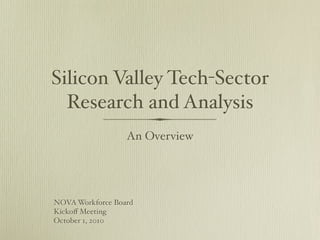Nova tech kickoff presentation
- 1. Silicon Valley Tech-Sector Research and Analysis An Overview NOVA Workforce Board Kicko? Meeting October 1, 2010
- 2. Project Goals ? Research and analysis that assists NOVA, work2future, Santa Cruz WIB, Santa Clara WIB, and their stakeholders in understanding Silicon Valley IT strategic advantages and growth trends. ? Develop sustainable relationships among the WIBs and their stakeholders, IT employers, economic developers, and education and training providers. ? Provide actionable results to help the WIBs assist their clients. ? Develop real-time labor market exchange.
- 3. Meet the Team ? Gordon Carr, GMC Strategies ? James Jones, Mid-Paci?c ICT Center ? John Carrese, Bay Area Center of Excellence ? Josh Williams, BW Research Partnership ? Steve Levy, CCSCE
- 4. Research Objectives and Program Overview Life Cycle Analysis Conduct a life-cycle analysis to determine the current and forecast competitive advantage for Silicon Valley in IT, including the factors creating the advantage and the sustainability of any such advantage.
- 5. Research Objectives and Program Overview Analysis of IT Providers Determine the size, focus, and forecast for IT companies in Silicon Valley, including factors contributing to growth or decline of various sub-sectors.
- 6. Research Objectives and Program Overview Analysis of Skill Demands Develop career lattices, billing rates, and skill pro?les for IT workers in Silicon Valley, including employer preferences in training and credentials - with a speci?c eye towards portable skills.
- 7. Project Deliverables ? Research paper with research ?ndings, including a taxonomy of IT sub-sectors ? A skills-based reference for job seekers ?Sustainable real-time data gathering and dissemination proces ? A major forum to release the ?ndings ? Training sessions for WIB sta? ? Speci?c recommendations for updating ?ndings
- 8. Project Plan: October/ November ? Qualitative Data Collection: Focus Groups and Executive Interviews ? Secondary Data Collection: Existing Literature, LMI, and Venture Capital Flow ? Social Media Tool: Communication Tool for Stakeholders and Feedback Mechanism as an Additional Source of Information
- 9. Project Plan: December/ January ? Quantitative Data Collection: Survey of 300+ Silicon Valley IT Employers ? Qualitative Data Collection: Additional Focus Groups ? Data Analysis
- 10. Project Plan: February/March ? Data Cleaning and Analysis ? Developing Recommendations ? Drafting Written Deliverables ? Preparing for Forum
- 11. Project Plan: April/May ? Present Findings ? Conduct Training ? Provide Support for Sustained Research and Relationships
- 12. Keys to Success ? Ability to Engage IT Stakeholders (employers, job seekers, WIB sta?, educators, labor, etc. - in ongoing real-time dialogues) ? Employer Buy-In and Candor ? Need information beyond talking points ? Leveraging SV WIB Stakeholder Relationships ? Provide Clear Value Proposition for Employers
- 13. Next Steps: ? Consider opportunities for promoting awareness of our research and buy-in from employers with a goal of recruiting more participants ? Identify collective resources - how can we best leverage our relationships, boards, and contacts?? ? Develop speci?c strategies for engaging employers in this process
- 14. Thank You! Philip Jordan Green LMI (617) 395-8898 phil@greenlmi.com www.greenlmi.com
Editor's Notes
- #5: Sharon Phase II: Collecting primary data to qualify existing and near-future labor market opportunities in green sectors and industries and identify possible gaps between demand and supply of prepared workforce. Later on in the presentation, we’ll be talking about some recently released work by the Centers as well as some potential future work. Future work will be somewhat dependent upon resources and our ability to identify priorities and develop strategies to leverage the resources we do have available to us.
- #6: Sharon Phase II: Collecting primary data to qualify existing and near-future labor market opportunities in green sectors and industries and identify possible gaps between demand and supply of prepared workforce. Later on in the presentation, we’ll be talking about some recently released work by the Centers as well as some potential future work. Future work will be somewhat dependent upon resources and our ability to identify priorities and develop strategies to leverage the resources we do have available to us.
- #7: Sharon Phase II: Collecting primary data to qualify existing and near-future labor market opportunities in green sectors and industries and identify possible gaps between demand and supply of prepared workforce. Later on in the presentation, we’ll be talking about some recently released work by the Centers as well as some potential future work. Future work will be somewhat dependent upon resources and our ability to identify priorities and develop strategies to leverage the resources we do have available to us.
- #8: Sharon Phase II: Collecting primary data to qualify existing and near-future labor market opportunities in green sectors and industries and identify possible gaps between demand and supply of prepared workforce. Later on in the presentation, we’ll be talking about some recently released work by the Centers as well as some potential future work. Future work will be somewhat dependent upon resources and our ability to identify priorities and develop strategies to leverage the resources we do have available to us.
- #15: Ozzie













